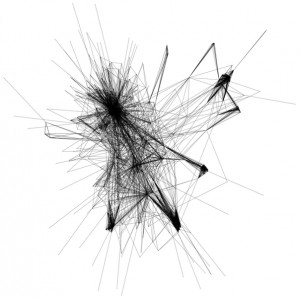“When we speak about the weather, it is assumed that we are talking about nothing, but is not the weather, in fact, a potent topic of cultural exchange, a bond that cuts through social distinction and economic class, superseding geopolitical border?” - Elizabeth Diller
Case Study – Blur Building, Elizabeth Diller and Ricardo Scofidio
Reading - “Rhizome”, G. Deleuze and F. Guattari
The blur building by Elizabeth Diller and Ricardo Scofidio is an example of architecture of atmosphere. By manipulating its materials, textures and macro climate the Blur building controls the experience the visitor receives while inside and creates a unique and unusual experience. The building is unique in way because of its primary material, mist. Water is pumped from the lake below and shot as fine mist through 35,000 high pressure nozzles around the metal frame.
The mist defines the form and spaces of the building. However the mist itself does not have a definite form or boundary. Its shape is always changing and there are no enclosures. This means the building does not have a clear distinction between of space. There is no definite interface between the interior and exterior of the building. A visitor cannot tell where the building starts or where it ends. Thus the Blur Building creates within itself a rhizomatic system of atmosphere.
This building was also intended to be a media installation which features smart raincoats or “braincoats”. These braincoats, which had embedded computer technology would respond to each other with LED lights when worn by the visitors while walking inside the building indicating either positive or negative affinity between them. The visitors get opportunity to connect with others who have similar interests. Thus the Blur Building connects people with similar interests, forming an ambiguous network of connections much like a rhizome.
Rhizome is a philosophical way of thinking developed by Delueze and Guattari in A Thousand Plateaus: Capitalism and Schizophrenia. They attack the traditional thought which is like the growth of a tree which follows a linear, hierarchical pattern, branching off at various points. It is an ‘arborescent’ system of organization and thought process. The Rhizome on the other hand has a more network like structure which has no beginning and end, or on the contrary, may have many beginnings and endings. It is an evolving system that is not constrained by boundaries.
The World Wide Web can be considered an example of Rhizome. It is a network which connects innumerable communication points like a rhizome, in which every point is connected to every other point. This connection is not centralized. There is no hierarchy according to which points are connected to and from another point. There is ‘deterritorialization’.
I think the Blur Building symbolizes the system of rhizome because it opposes the traditional predefines approach to design, much like how the Rhizome breaks away from conventional thought process.
As for topic of research, I am very interested in studying and understanding the concept of rhizome further. On a parallel line I would like to research on the inherent existence of this philosophy in the vast field of architecture and its practice. It would be interesting to study examples of architecture whose structures are considered analogous to the rhizome such as slums and towns and cities which grow in an unplanned and organic pattern.
Image reference - http://urbagram.net/microplexes/

